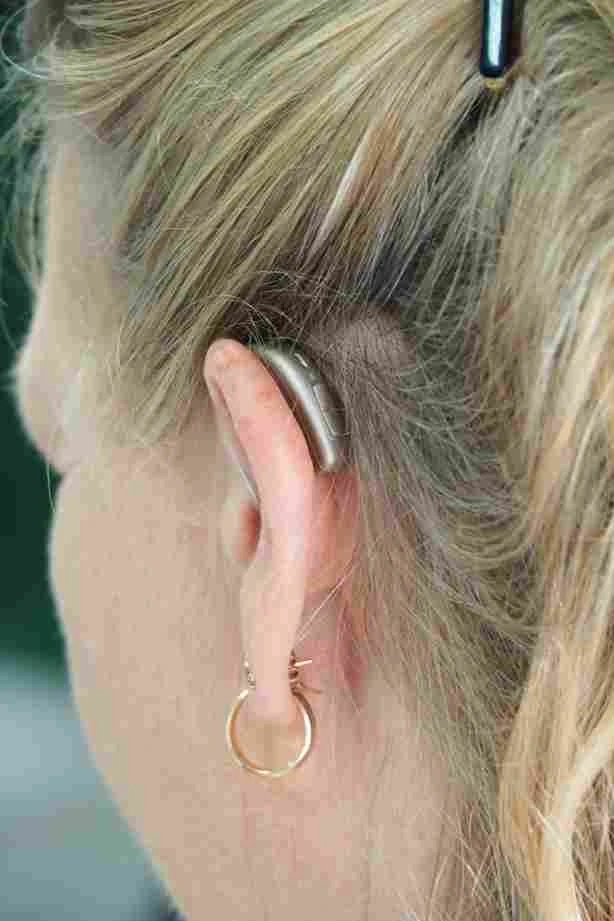A hearing aid is a medical device that amplifies sound in a way optimized for your specific type and degree of hearing loss. Today’s advanced options include tinnitus therapy and wireless connections that enable streaming of music, phone calls and TV audio.
A hearing aid consists of two parts: the main device that sits behind your ear and the receiver (tiny loudspeaker) fitted in an earfitting sitting in your ear canal. There are many sizes and styles to choose from.
In-the-ear (ITE)
These devices are custom made based on an impression of your ear, and fit snugly inside the outer ear. They are available in two styles: full shell ITE hearing aids that fill most of the concha or bowl area of the outer ear, and half shell ITE hearing aids that only fit the lower portion of your outer ear. Both styles are suitable for those with mild to moderately severe hearing loss.
Like CIC hearing aids, ITE hearing aids are custom molded to fit your ear, but they extend a bit farther out of your ears and are more visible than the completely-in-canal (CIC) models. This slightly larger size allows for a few more features to be incorporated into the ITE hearing aids, such as controls for volume and programs. Moreover, they come in flesh-toned colors that help them blend in with your skin tone so they’re less noticeable.
One particularly promising development is the development of miniature directional microphones. These mics allow the wearer to clearly hear sounds from a specific direction while filtering out background noise. NIDCD-supported researchers are studying the ear structure of the fly Ormia ochracea to learn how to replicate this natural ability in tiny microphones for use with hearing aids.
Another benefit of ITE hearing aids is that they are typically more comfortable than other types of hearing aids. This is because they don’t press against the ear canal and do not create an uncomfortable sensation when you move your head. Moreover, since they sit inside the ear, they are exposed to less wind and perspiration than other types of hearing aids.
However, the size of ITE hearing aids can limit their ability to provide sufficient power for those with more severe hearing loss. If you have an advanced level of hearing loss, it’s best to consider a behind-the-ear (BTE) or receiver-in-the-canal (RIC) model. They are more powerful and offer the flexibility to handle more challenging listening environments. Your audiologist will be able to help you determine which model is best for your needs.
Behind-the-ear (BTE)
BTE hearing aids sit behind or on top of the outer ear and route sound down into your ear canal via tubing. Unlike IIC and CIC styles that don’t completely block the ear canal opening, BTE models come with a clear tube and a tip designed to fit snuggly into your ear. The tubing and tip are often made from a medical-grade plastic, so they’re easy to clean and less likely to get clogged with earwax or other debris.
The main component of a BTE style is the housing, which contains the processor, amplifier, microphone ports and battery. The microphones collect sounds from the environment, which are then amplified and converted into digital signals on a computer chip. The processor interprets these signals based on your individual listening needs and hearing loss profile. It can also adjust the sound based on your surroundings, such as when you are in a noisy room.
After the sound is processed, it’s transmitted through a small speaker in your ear, which then converts the signal into audible sounds. The speaker is commonly connected to an earmold, which your hearing care professional constructs based on a mold of your ear or a simple dome that fits in the opening of your ear canal. This type of hearing aid is typically more visible than others because of its size, but you can find styles that are sleek and discreet.
Many people who need BTE hearing aids have moderate to severe loss of hearing. “These devices provide a good amount of power to help with speech understanding and are able to handle higher-tech features, such as directional microphones and volume controls,” says Lindsey Banks, a fellow of the American Academy of Audiology and Forbes Health Advisory Board member. She recommends the Oticon More mini-BTE, which uses AI sound technology to improve speech clarity.
Regardless of your unique budget and lifestyle, there’s a way to afford a high-quality BTE device. If you have private insurance or an FSA or HSA account, you can use those funds to pay for your hearing aids and reduce your out-of-pocket costs. If you don’t have access to any financial resources, consider speaking with a local hearing aid professional about financing options.
Receiver-in-canal (RIC)
This is one of the most popular hearing aid types available and for good reason – it is both discreet and incredibly easy to use. A tiny wire connects the case to a receiver which sits in your ear canal, meaning that you can hear sounds more naturally and without occlusion. They are perfect for people with mild to moderate hearing loss, but they can also be used by people with more severe and profound hearing loss.
The casing that RIC hearing aids come in is usually very small and slimline, which means they fit almost seamlessly behind your ears. The tiny wire that connects this to the ear dome is also very thin and therefore virtually invisible, making them a great choice for those looking for a discreet solution.
Unlike BTE hearing aids that contain both the receiver and microphone, RIC hearing aids separate these functions to prevent feedback and occlusion issues. This allows them to be very small and also allows your ear canal to remain open, which is a big advantage for many. Additionally, modern feedback control has made RIC hearing aids a very reliable option for anyone with concerns about whistling or squealing sounds in the ear.
As a result of the design of these hearing aids, however, it is important to understand that they can be more susceptible to wax build-up and natural ear moisture than other hearing aid styles. As a consequence, they may require more regular maintenance and cleaning and should be changed out more frequently than other hearing aid types.
This can be done very easily, and most manufacturers have helpful Youtube videos or instructions showing how to replace your ear receiver if it becomes damaged or blocked by wax etc. However, you do need to be able to dexterously handle the earpiece to remove it and then to place the new one in the ear. Generally, this is not an issue for most users but it might be an important consideration for those with limited dexterity.
Receiver-in-the-ear (RITE)
The body of a RITE hearing aid sits behind your outer ear, and a thin receiver wire extends from the body over your head and into the ear canal. The receiver is fitted with a soft tip that sits just inside the ear canal without sealing it, which offers a more natural sound. RITE devices can fit a wide range of hearing levels and come in many different colours. However, they may require a little more manual dexterity to handle when inserting and taking out the battery.
Like BTE devices, RITE hearing aids have microphones that pick up sound and convert it into electrical signals that are then amplified. They also have a speaker that transmits the amplified signal into your ear. However, unlike BTE devices, a RITE’s microphone and speaker aren’t in close proximity, which reduces the likelihood of feedback (the whistling noise that can occur when the microphone is too close to the loudspeaker).
A RITE hearing aid can be very easy to wear for those with vision or dexterity challenges. It’s also a great option for those who are new to wearing a hearing aid, or for those who prefer a more discreet device than a full shell that completely covers the outer ear.
RICs are one of the most popular hearing aid options available. They have the cosmetic appeal of In the Canal devices and the power, flexibility, and sound quality of Behind the Ear (BTE) devices. They can also be fitted with an array of features that address specific hearing needs and environments, including tinnitus options, high-quality streaming, and game-changing acoustic motion sensors.
If you do experience a problem with a RIC or a RITE device, it’s a good idea to contact your hearing care provider right away. In most cases, they can help you fix the issue with a small adjustment to how the device is fitted. In addition, it’s important to know that you can replace the receiver in a RIC or RITE hearing aid if the sound quality starts to deteriorate. With some brands, such as Widex Super, you simply pull out the old receiver where it connects and then push in a new one.


